GeForce RTX 3080 vs Radeon RX 6800 XT: High-end GPU Face Off
A head-to-head battle between the penultimate AMD and Nvidia cards.
Today, we have a high-end grudge match between the GeForce RTX 3080 and Radeon RX 6800 XT, two of the best graphics cards currently available. Graphics cards on a store shelf are as rare as hen's teeth these days, and that makes knowing what you're buying that much more important. If you're going to camp out for a GPU, it better be a good one, and these both rank near the very top of our GPU benchmarks hierarchy. Let's pit the two against each other to determine which one's the better choice.
Last year, the graphics card market picked up in multiple big ways. For the first time in many years, both Nvidia and AMD released new GPU architectures with graphics card lineups that offered massive generational improvements. Nvidia's RTX 3080 and the Ampere architecture arrived first, bringing new levels of performance, faster ray tracing and tensor operations, and more bandwidth thanks to GDDR6X. AMD's RX 6800 XT and the RDNA2 architecture arrived a few months later, with AMD joining the ray tracing club for the first time, and with a relatively massive 128MB Infinity Cache to help improve effective bandwidth.
The GPUs in question have been on the market for roughly half a year now. In past generations, the hype around a GPU release would have subsided by now, but with the current market situation and GPU shortages, most people haven't had a chance to get their hands on either card yet. Both cards are impressive, and anyone lucky enough to have snagged one during this unprecedented graphics card drought should be ecstatic to have a GPU at all. Still, there are pros and cons to each, and if you're in the market for an expensive GPU it's a good idea to weigh the differences to make sure you're satisfied with your purchase when you make one.
As with our other GPU face offs, we'll look at performance, price, features and tech, drivers and software, and power and efficiency in order to determine a winner. Those categories are listed in order of decreasing importance, in our view at least, so we'll start with the critical aspects and move on down the list from there.
Gaming Performance: RTX 3080 vs RX 6800 XT
GPUs are used for many purposes these days, but gaming is still the number one reason consumers spend big bucks on these devices, and people buying high-end cards expect top-notch performance. We put the RTX 3080 and the RX 6800 XT to the test with a 13-game gauntlet in three resolutions to see which GPU deserves the crown. The results weren't as definitive as we would like, but we've got additional benchmarks that will help sway our final verdict.
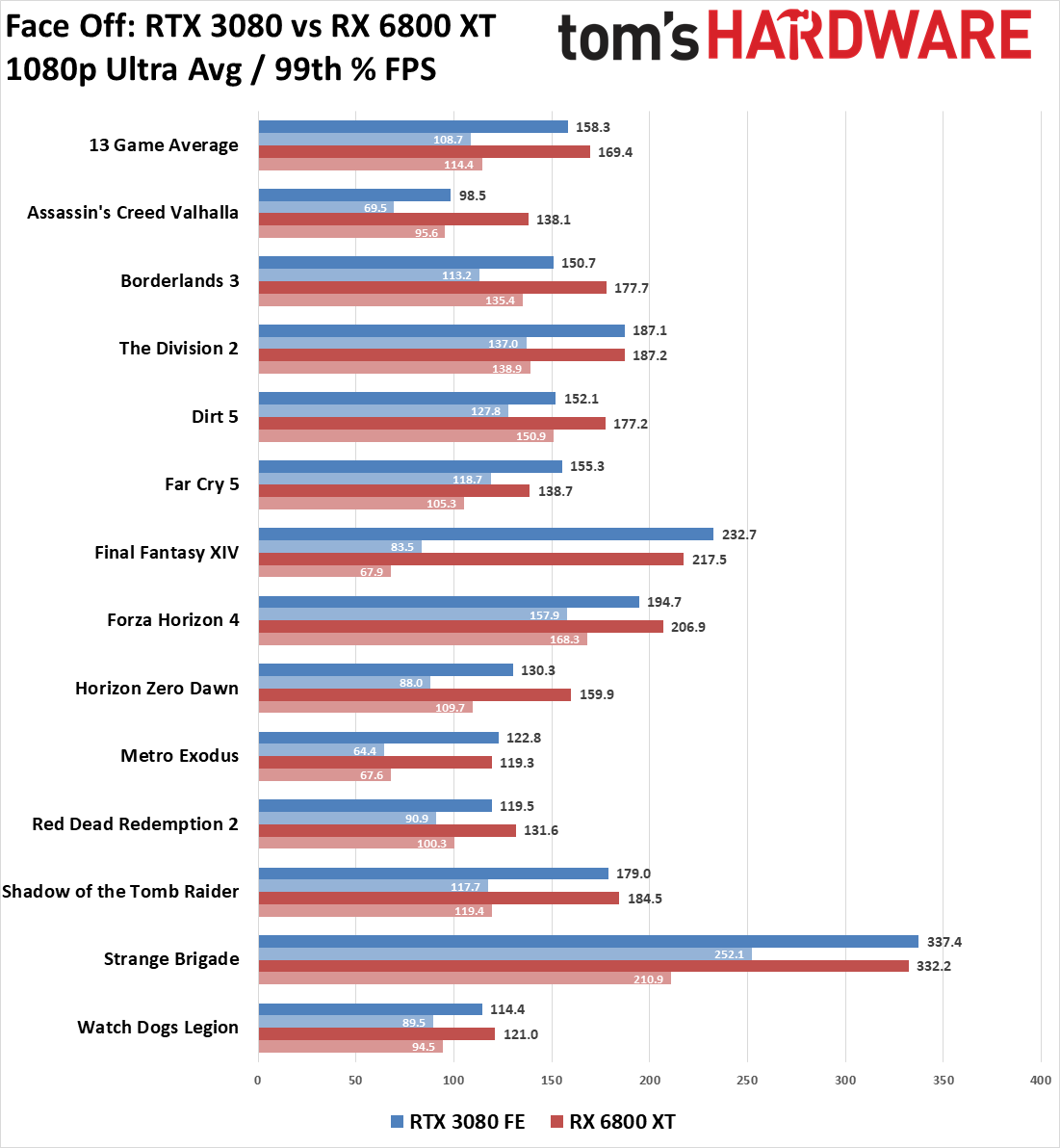
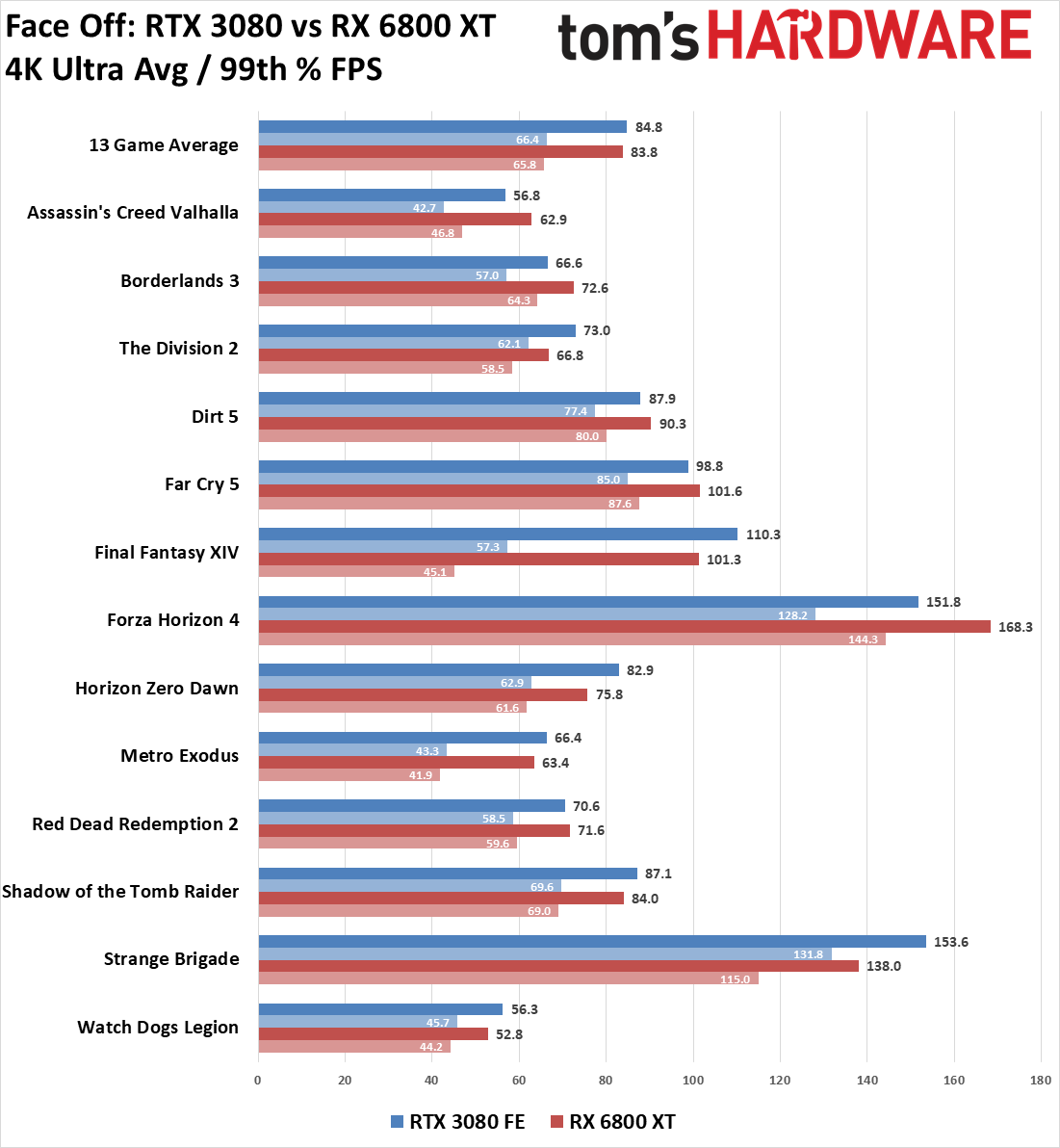
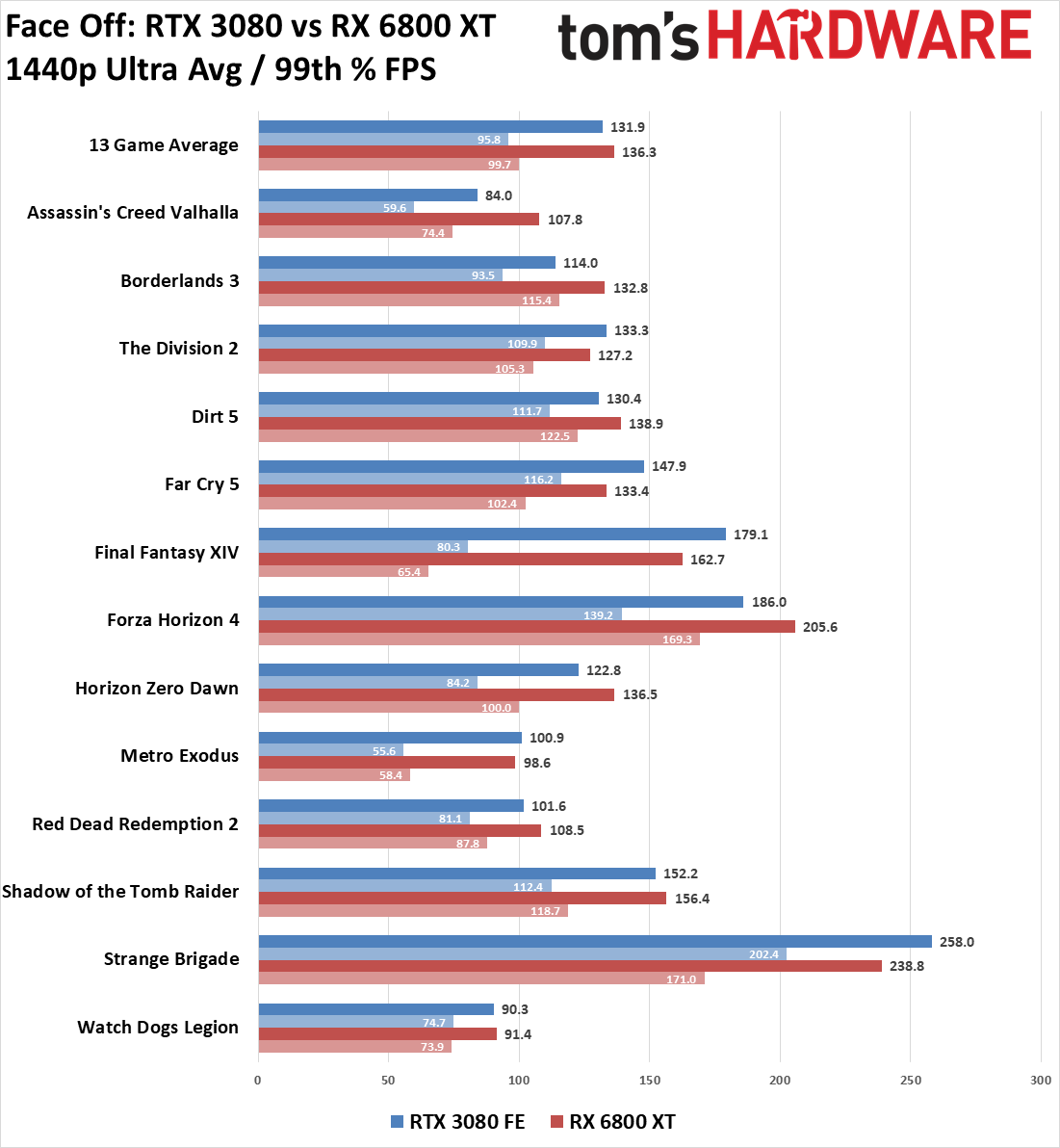
If you're gaming at 1080p, both cards are more than fast enough—perhaps even overkill. Overall, the RX 6800 XT has a slight edge on the RTX 3080, with an average 169.4 FPS across all 13 games compared to the 158.3 FPS. AMD comes out slightly ahead in many games, with significant leads in several AMD promoted games like Assassin's Creed Valhalla, Borderlands 3, and Dirt 5.
Increasing the resolution to 1440p shrank the delta between the two cards several percent, though the 6800 XT held onto the overall lead. Take that with a grain of salt, though, as the both cards still cranked out over 100 fps in nearly every game (Watch Dogs Legion, Metro Exodus on the 6800 XT, and Assassin's Creed Valhalla on the 3080 being the exceptions).
Gaming at 4K, even with today's best GPUs, remains a challenging feat, but both cards are capable of driving high-end games at this resolution with acceptable frame rates — mostly, as long as you're okay with closer to 60 fps in many games. The 13-game average now puts the RTX 3080 slightly ahead of the RX 6800 XT, flipping the 1440p results, and in most cases the performance delta between the two cards remained negligible.
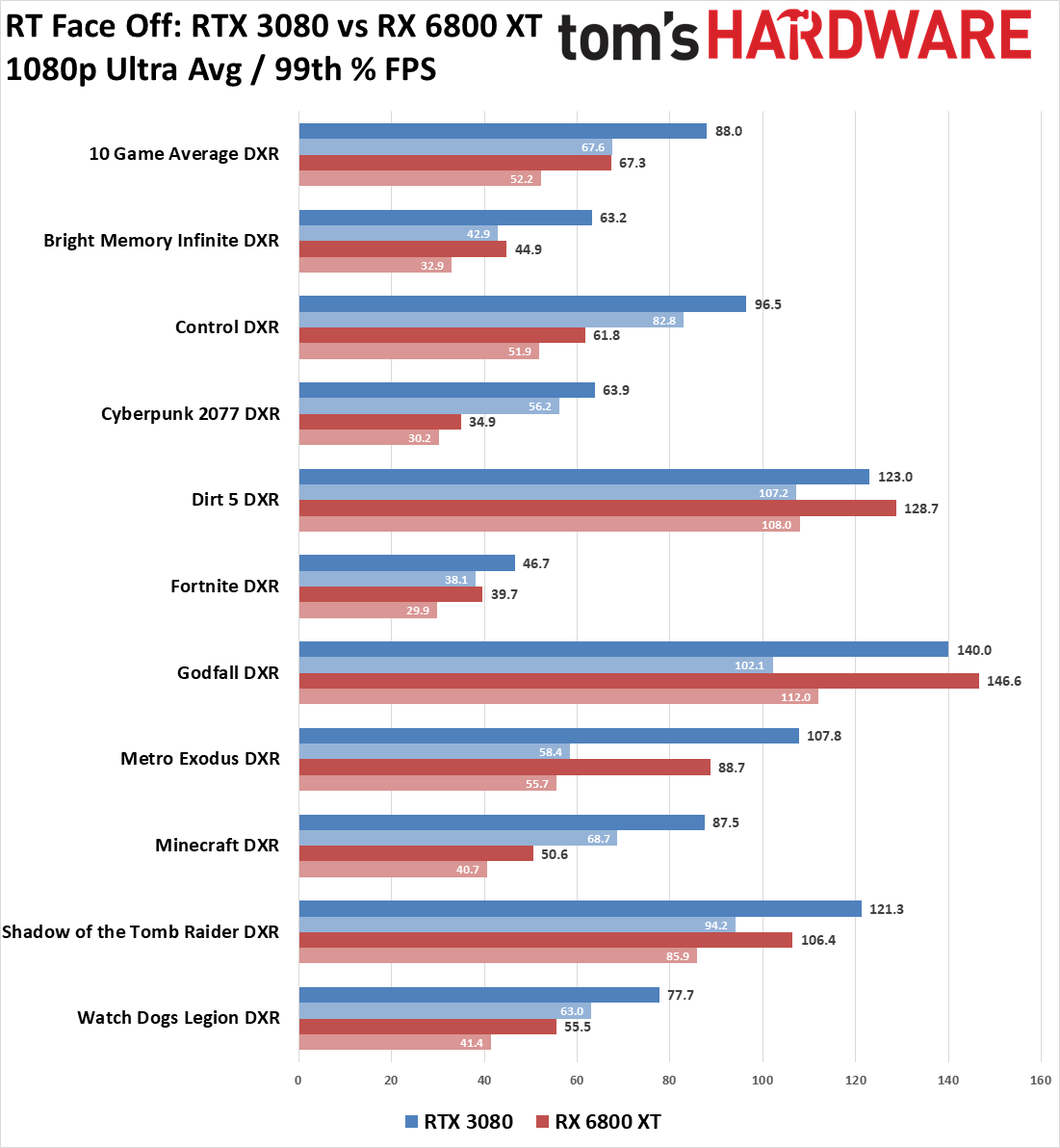

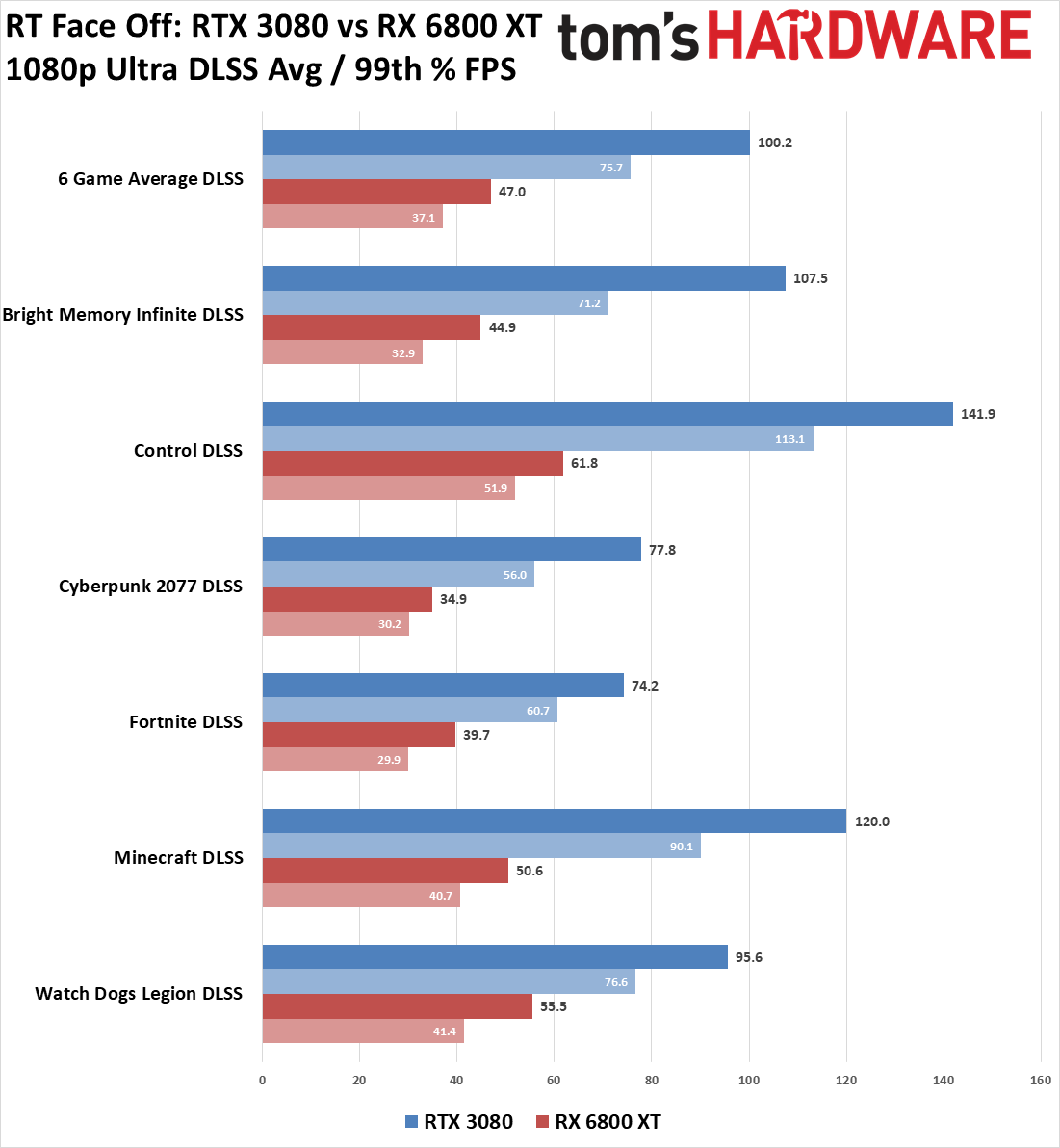
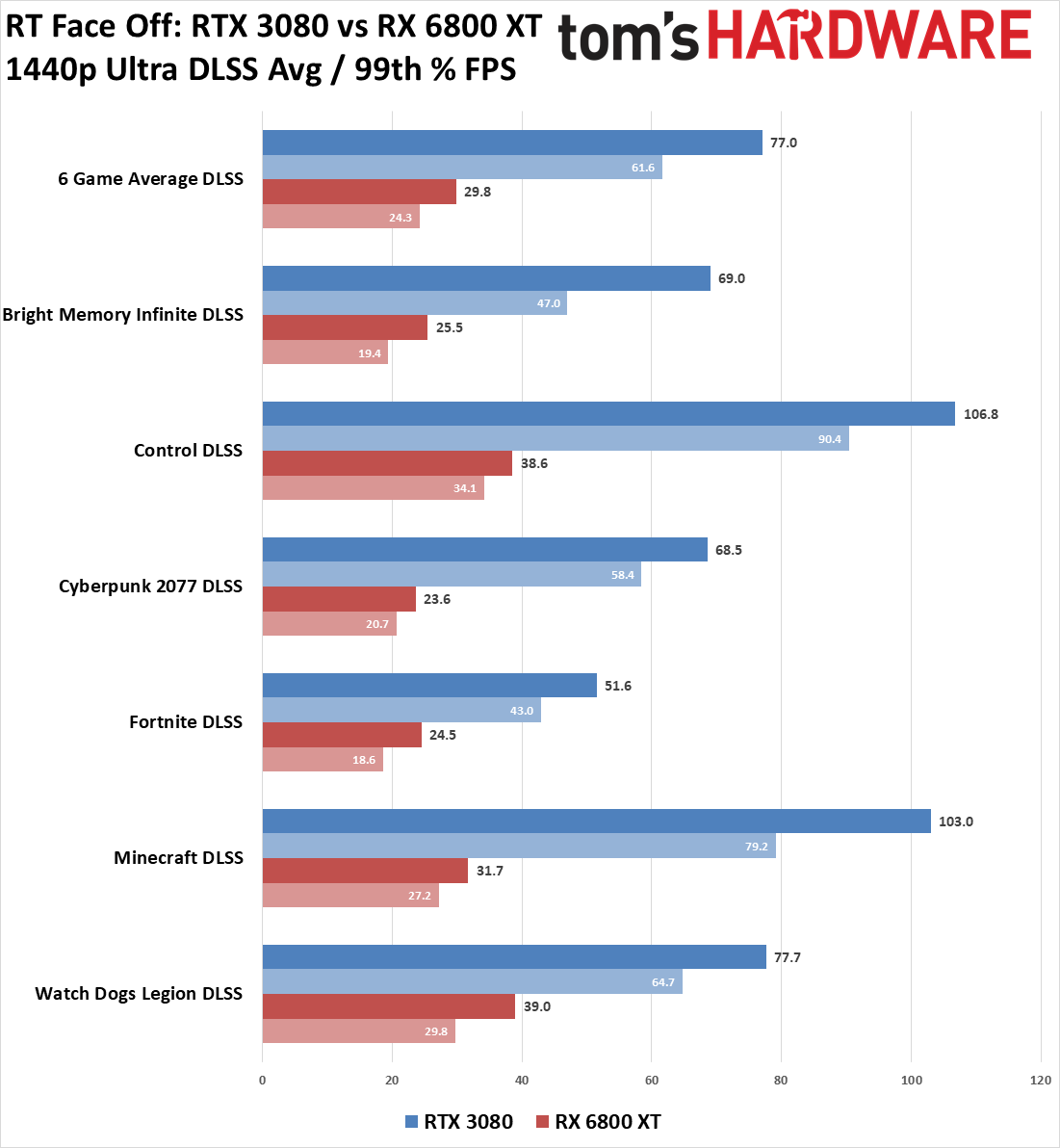
The RX 6800 XT looks like it wins by a hair overall, especially if your favorite game happens to be AC Valhalla for Borderlands 3. But what if we go beyond rasterization and run games with ray tracing and/or DLSS technologies? We've omitted the 4K testing this time — it's really only viable with DLSS anyway — and switched to testing ten games with DirectX Raytracing (DXR) and six games with DLSS 2.0. We're not going to break down every chart, but the overall standings change dramatically once DXR and DLSS come into play — and a game doesn't need to use DXR to benefit from DLSS.
Running native 1080p or 1440p, Nvidia's lead in DXR games averaged 30% to 35%, and it was over 50% in three of the games we tested. AMD still came out with small leads in Dirt 5 and Godfall, both AMD promoted games, but we want to go on record (again) by noting that the DXR shadows in those games really don't strike us as particularly important (and the same goes for Shadow of the Tomb Raider).
Enable DLSS Quality mode, which is difficult to tell apart from native rendering in our experience, and it's not even remotely close. Yes, Nvidia's GPUs render fewer actual pixels and rely on machine learning to scale the result, but if you can't readily see the difference — and that's looking at still frames — does it matter? In the six DLSS + DXR games we tested, the smallest lead for the RTX 3080 was 72% (Watch Dogs Legion at 1080p), but in most games the 3080 was more than double the performance of the RX 6800 XT.
Winner: Nvidia
You can't really go wrong with either of these cards. They both deliver ample performance for gaming at any resolution. If we have to pick a winner, we'll take Nvidia's DLSS tech (more than the DXR superiority) as a smart way of providing often significant improvements to performance. AMD needs a viable alternative to DLSS 2.0, hopefully something that clearly matches it in quality (FidelityFX CAS doesn't, once you apply upscaling). Given Unreal Engine's and Unity Engine's support for DLSS, we expect plenty of upcoming games will benefit.
Price: RTX 3080 vs RX 6800 XT

Nvidia kicked off this GPU generation with the RTX 3080 hitting the market in September 2020 for a suggested price of $699. AMD came in a bit later with a November 2020 release for the RX 6800 XT, landing with a lower MSRP of $649. Sadly, neither of those prices reflect the current state of the market — not even close. With extremely limited availability, we're seeing massively inflated prices from scalpers and effectively nothing available at MSRP.
The GPUs at this tier have never been what you would call affordable options. The GeForce RTX 3080 is what Nvidia considers its flagship graphics card (the 3090 is apparently chopped liver to Nvidia CEO Jensen Huang), with a price to match the previous generation RTX 2080 Super and GTX 1080 Ti. AMD hasn't had a competitive offering in this price bracket for a while (no, the Radeon VII and R9 Fury X weren't really competitive), so this is the first time ever that AMD has had a single-GPU solution worth paying $650 or more in our opinion. It's too bad that neither company is currently able to keep up with demand, as those prices sound downright inviting these days.
A quick look at our GPU Pricing Index shows that RTX 3080 and RX 6800 XT cards are selling for extreme premiums on eBay, which is currently the easiest place to pick up a graphics card if you're willing to pay double or triple the official price. And good luck finding one in a store at MSRP. Since their launch in late 2020, the RX 6800 XT and RTX 3080 have been nearly impossible to find, and the madness isn't expected to slow down any time soon. Demand for GPUs is at an all-time-high right now and production is constrained by multiple factors.
On eBay, then, it's $2,200 (give or take) for the RTX 3080 versus $1,525 for the RX 6800 XT. Interestingly, however, the regular Newegg Shuffle frequently puts up cards using both GPUs. There, the RTX 3080 bundles typically cost in the neighborhood of $1,300 while the RX 6800 XT bundles have a similar price (assuming the bundled components are similar prices, anyway). There have also been far more RTX 3080 bundles listed over the past month than RX 6800 XT, so theoretically it's 'easier' to score the 3080. Realistically, though? We haven't been selected for a single 3080 or RX 6000-series bundle, and we've tried on nearly every one. Back to scalpers, then, or wait until 2022...
Our most recent numbers indicate that a Radeon RX 6800 XT is a much better deal than a GeForce RTX 3080 on eBay, probably because the 3080 is 50% faster for Ethereum mining. The average eBay price for a Radeon RX 6800 XT was around $1,500 at the time of writing. That's almost a 2.5X premium over the MSRP. However, if you prefer team green, expect to pay significantly more than that. eBay pricing on the RTX 3080 is hovering around $2,250, 3.2x the MSRP of a Founders Edition card.
Winner: AMD, but actually, no one
With the average eBay price for a Radeon RX 6800 XT currently sitting at $750 less than the typical GeForce RTX 3080 card, the Radeon appears to be the better value. The reality is, at these prices, the only winner is the scalper taking profits. If you get lucky with a Shuffle, pricing looks roughly tied — but then you're down to pathetic odds. If you need a new GPU, try to find one for as low a price as possible and you can use our RTX 3080 stock tracker to help. We can't support paying two to three times the MSRP for either of these cards.
Features and Technology: RTX 3080 vs RX 6800 XT

With every generation of graphics card comes new technologies meant to improve your gaming experience. In most cases, AMD and Nvidia have direct counterparts for each other's technology, but there are a handful of exceptions that really set these cards apart in various ways.
Nvidia's RTX GeForce cards support Deep Learning Super Sampling (DLSS), a technique to increase the image resolution with minimal impact on image quality. DLSS leverages Nvidia's AI technology to take low resolution rendered images and infer the placement of pixels to increase the output resolution. Currently, AMD doesn't offer a direct counterpart to DLSS technology, although FidelityFX Super Resolution technology could even the playing field when it lands later this year. Until then, Nvidia has a clear performance advantage with DLSS games.
AMD and Nvidia both support ray tracing, which offers image quality improvements that are sometimes quite pretty, but they don't offer much in the way of gameplay improvements. Ray tracing does impact the framerate that your GPU can deliver, and as noted above, Nvidia's GPUs tend to easily beat AMD in ray tracing games. That's likely thanks to the fact that Nvidia is on round two of RT hardware, while AMD is still on round one.
Both AMD and Nvidia offer refresh rate synchronization technology, which dynamically syncs your monitor's refresh rate with your GPU’s frame rate output. Nvidia's G-Sync requires an Nvidia GeForce GPU paired with a G-Sync certified (or G-Sync Compatible) display. FeeSync is AMD's answer to G-Sync. Both technologies match your display's speed with output from your GPU, but AMD's solution is usually more affordable. Nvidia requires certification and licensing from display manufacturers, whereas AMD's solution is royalty-free and free to use, giving display makers a broader opportunity to support Freesync. On the other hand, G-Sync typically works better, likely due to Nvidia's strict requirements. Furthermore, Nvidia cards can run with G-Sync on most of the top FreeSync displays, whereas AMD GPUs are not compatible with G-Sync technology. For a more detailed analysis see our FreeSync versus G-Sync face-off.
Another display technology Nvidia offers is Reflex — both as a software and hardware solution. In games that fully implement Reflex (Apex Legends, Call of Duty: Black Ops Cold War, CRSED: F.O.A.D., Destiny 2, Enlisted, Fortnite, Mordhau, Overwatch, Rainbow Six Siege, Valorant, and Warface), it offers a significant latency reduction that can help competitive gamers. That's why that list is full of multiplayer games. Again, AMD doesn't have a direct counterpart. Elsewhere, Nvidia's Ultra-Low Latency tech and AMD's Anti-Lag go for a similar end goal (lower latency), but neither is as good as Reflex.
AMD may be lacking in some software features, but it has the clear win in memory capacity. Whereas Nvidia's GeForce RTX 3080 comes equipped with a not too shabby 10GB of GDDR6X memory, the Radeon RX 6800 XT packs a whopping 16GB of GDDR6 memory. So far, however, there are almost no games where VRAM capacity makes a clear difference.
Winner: Nvidia
While both companies offer similar feature sets, Nvidia does a better job implementing their versions. G-Sync is generally superior to FreeSync; DLSS doesn't have a counterpart, yet; and Reflex performs better than Anti-Lag in our experience. The extra memory on the Radeon is not a reason to give up Nvidia's impressive features.
Drivers and Software: RTX 3080 vs RX 6800 XT
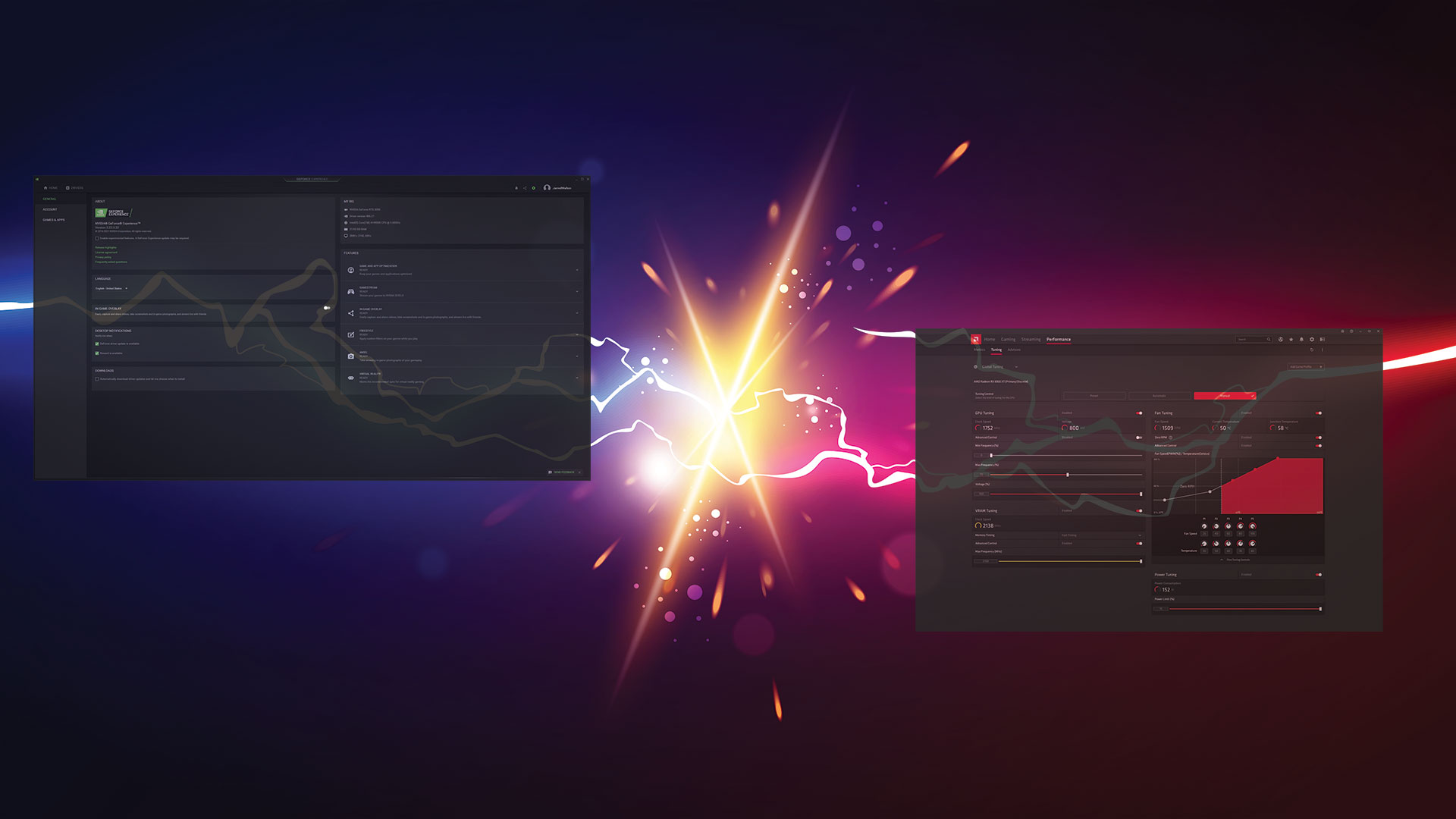
AMD and Nvidia release regular driver updates for their GPUs. In AMD's case, the company drops annual overhauls of its Radeon drivers (currently Radeon Adrenaline 2020 — the April 2021 update added some new stuff but kept the 2020 branding), which usually include new features and a UI update. Additionally, AMD puts out regular monthly updates that address bugs and improve performance in some games, as well as extra updates for new game releases.
Nvidia maintains a similar release schedule for its GeForce drivers. It doesn't always have a monthly driver update, but you can count on having Game Ready Drivers on launch day for most major game releases.
Radeon drivers are generally not WHQL (Windows Hardware Quality Labs) certified, which perhaps enables AMD to push out updates more frequently. The trade off is bugs can slip through the cracks when updates roll out so quickly. Nvidia's drivers are usually WHQL certified (outside of hotfix releases), which reduces the release frequency, but decreases the likelihood of a big bug slipping through. In either case, however, testing doesn't always catch things, and bugs do occasionally happen.
AMD and Nvidia have different approaches to their driver user interfaces. Nvidia splits its GeForce driver options into two applications. Nvidia Control Panel handles the GPU settings, such as resolution, texture filtering, vertical sync, low latency mode, power management, and more. The control panel also handles display configuration settings, such as color, rotation, and multi-display setups. Nvidia GeForce Experience handles game settings, driver updates, and includes game streaming and recording features. To access the GeForce Experience features you must log in with an Nvidia user account.
Additionally, Nvidia offers Nvidia Broadcast, an AI-enhanced broadcasting solution that uses the GeForce RTX Tensor cores to do things like clean up the noise from your microphone and remove the background behind you without a green screen. It's not perfect, but it's actually quite impressive compared to the background removal algorithms in other apps like Zoom or Google Meet.
AMD takes a somewhat more streamlined approach in that the Radeon driver software is a one-stop-shop for all your Radeon GPU settings and features. The Radeon Adrenaline 2020 software suite includes automatic driver updates, game performance profiles, and built-in broadcasting software to stream and record your gameplay. AMD even offers an Instant GIF button to create animated images of your most memorable gaming moments. The Radeon software also offers performance metrics logging and a tuning section with automatic overclocking profiles and settings for manual adjustment.
Winner: Tie
Both Nvidia and AMD have different advantages with their drivers and accompanying software, but ultimately they offer generally equivalent experiences. AMD's performance monitoring can be useful, but so are the AI-enabled features that Nvidia Broadcast brings to the table. As far as driver updates, both companies release updates regularly and you can usually expect a new driver from each side when notable games hit the market.
Get Tom's Hardware's best news and in-depth reviews, straight to your inbox.
Power Consumption / Efficiency: RTX 3080 vs RX 6800 XT
When you're playing around with graphics cards at the level of the RTX 3080 and the RX 6800 XT, you're going to need a fair bit of power, and efficiency is still an important consideration when selecting a GPU. The amount of juice your GPU needs affects your power supply requirements. GPUs are also the largest factor when considering the carbon footprint of your gaming system.
In past generations, AMD's GPUs would often draw far more power than Nvidia's counterparts, but that's not the case with the current lineup. In our testing, Nvidia's RTX 3080 draws more power than AMD RX 6800 XT. Nvidia's card even pulls more power than AMD's more performant RX 6900 XT. A lot of that is thanks to AMD's use of TSMC 7nm N7 lithography compared to Nvidia's use of Samsung "8nm" 8N tech, with TSMC generally costing more — and it's in higher demand, which means it can be more difficult to get sufficient supply.
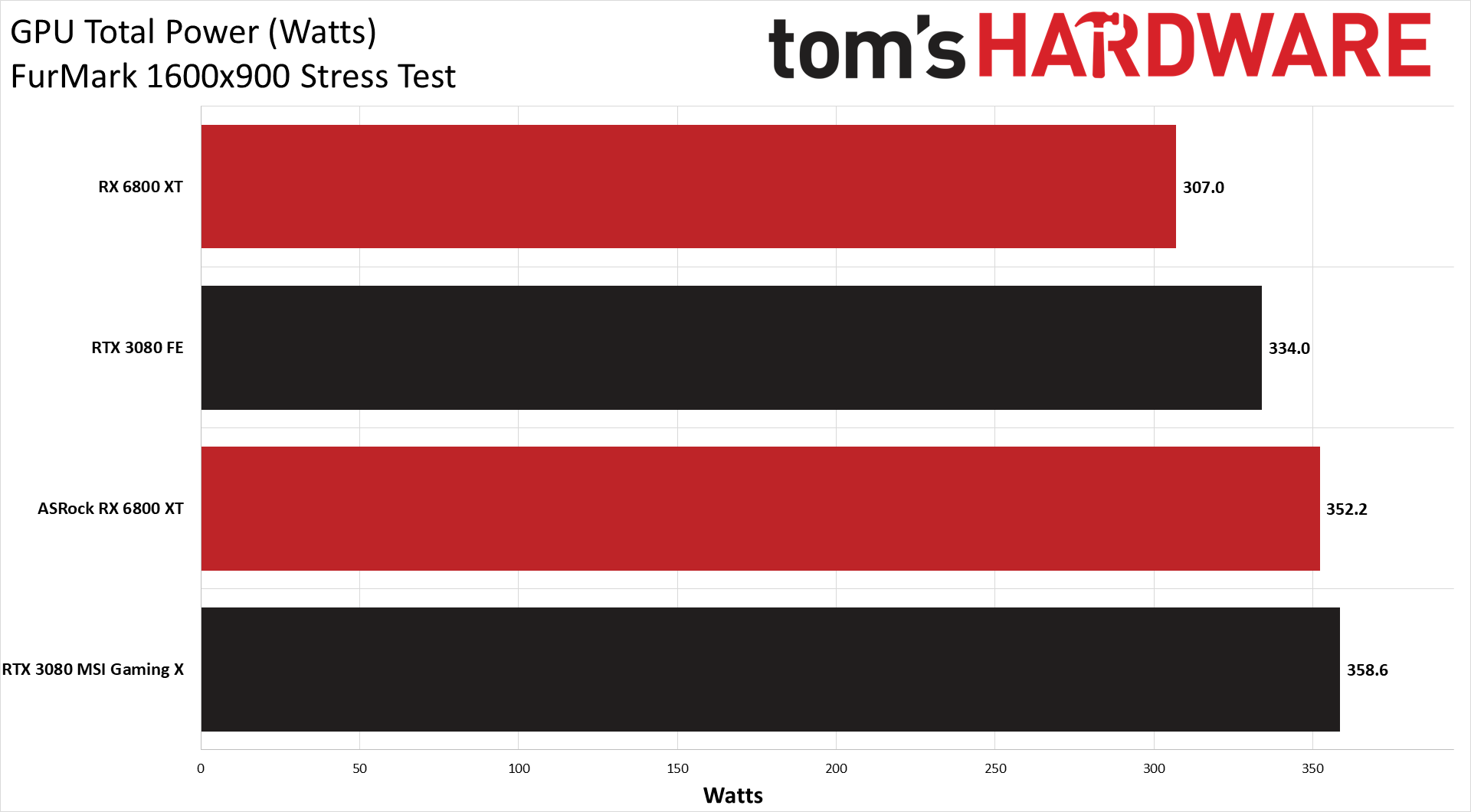
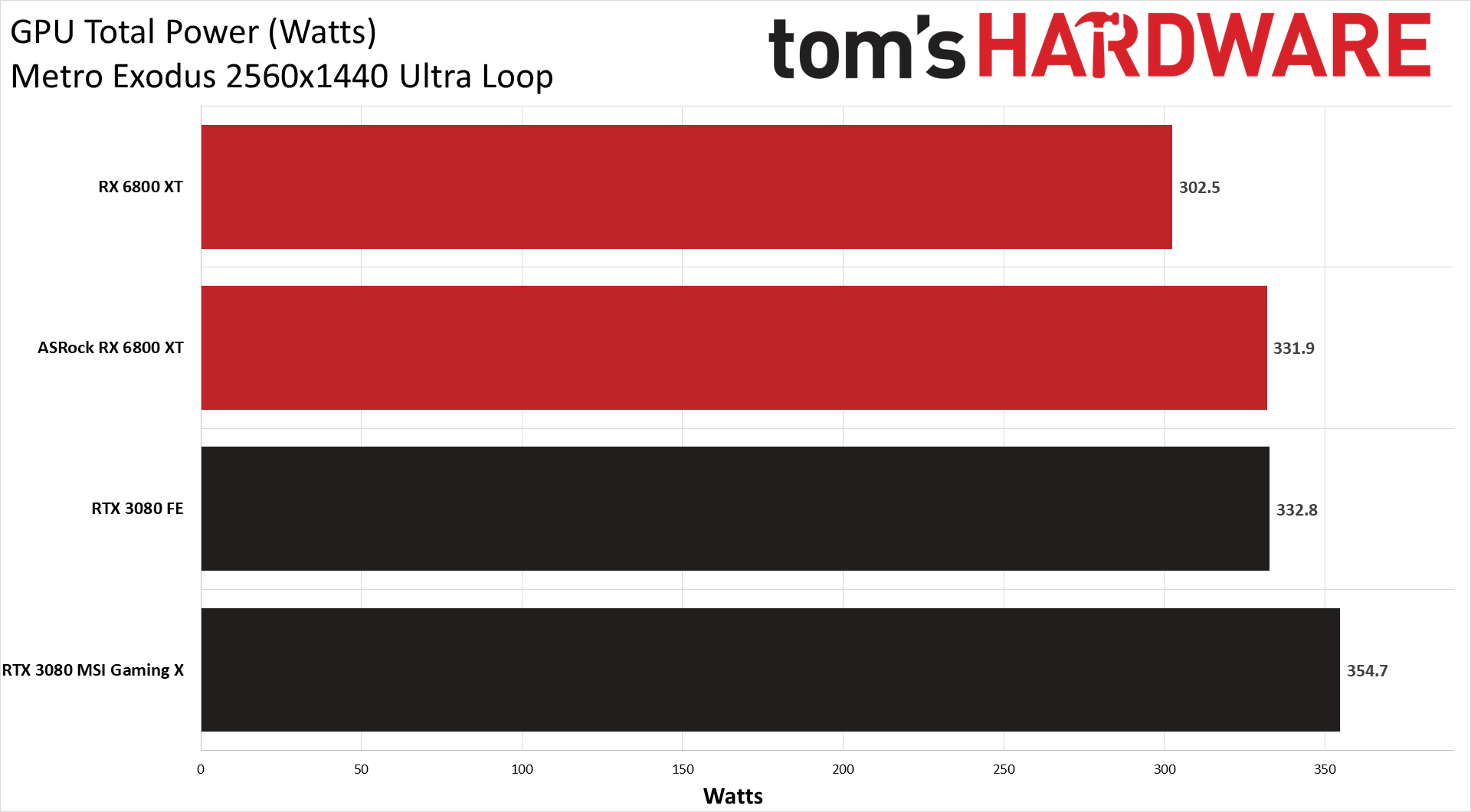
The gap in power use between the RTX 3080 and the RX 6800 XT isn't particularly wide, however, especially if you look at third party cards. Nvidia's 3080 Founders Edition pulls roughly 10% more power from the wall than AMD's reference 6800 XT. For factory overclocked cards, however, the gap can all but disappear — depending on the card models, naturally.
For games that don't support ray tracing features, the performance difference between the two cards doesn't justify the additional power consumption of the GeForce. Nvidia's ray tracing and DLSS performance advantage make up for the deficit, though.
Winner: AMD
AMD's RX 6800 XT draws slightly less power than the RTX 3080 with very close performance numbers. Unless you plan to take full advantage of Nvidia's proprietary features, the 10% power savings is probably worth going with AMD.
Bottom Line: RX 6800 XT vs RTX 3080
| Round | AMD Radeon RX 6800 XT | Nvidia GeForce RTX 3080 |
|---|---|---|
| Gaming Performance | Row 0 - Cell 1 | ✗ |
| Price | ✗ (nominally) | Row 1 - Cell 2 |
| Features and Technology | Row 2 - Cell 1 | ✗ |
| Drivers and Software | ✗ | ✗ |
| Power and Efficiency | ✗ | Row 4 - Cell 2 |
| Total | 3 | 3 |
The Radeon RX 6800 XT and the GeForce RTX 3080 are relatively well matched cards, but at this tier, it's almost too close to call. For a lot of people, performance will be the number one consideration, but the winner and margin of victory can vary greatly depending on the game and settings being used. DLSS makes the RTX 3080 a formidable competitor as well, and anyone that cares about ray tracing will be better served by the RTX 3080 — right now it's the card we'd most like to recommend based on official prices.
That's the problem, though. Street prices are generally terrible, as is availability. The RTX 3080 appears to be in wider circulation, but for normal gamers, paying $1,000 or more just for a graphics card is asking far too much. Anyone willing to pay scalper prices, however, will find the Radeon RX 6800 XT costs about $700 less than the RTX 3080, and it produces higher frame rates in many games. Unless you're mining on the side, in which case the hashing performance of the 3080 might make it worth the added cost.
When these cards sell for MSRP — if they ever do before being replaced by future cards — the tables could turn. Don't expect that to happen in 2021, though. The GPU shortage will likely drag on until next year, and scalpers will continue to manipulate the market prices.
And there's the rub. Our rankings and overall preferences mean nothing if you can't get your hands on either of the cards at acceptable prices. If you manage to acquire either a Radeon RX 6800 XT or a GeForce GTX 3080, count your lucky stars and be happy with your purchase. That's especially true if you managed to pick it up at anywhere close to MSRP (i.e., under $1,000).
Overall Winner: Tie, until (unless) availability improves a lot
Kevin Carbotte is a contributing writer for Tom's Hardware who primarily covers VR and AR hardware. He has been writing for us for more than four years.
-
Kahless01 no wonder nvidia threw a fit about people publishing rasterized numbers. they get whooped and use more power doing it. and thats with amds atrocious drivers.Reply -
digitalgriffin Reply
At 4K NVIDIA wins even without DLSS. At these prices these should be 4K cards.Kahless01 said:no wonder nvidia threw a fit about people publishing rasterized numbers. they get whooped and use more power doing it. and thats with amds atrocious drivers.
Throw in DLSS 2.0 and it's game over (for titles that support it) -
ezst036 Perhaps the most impressive point of all is that AMD's card is just as competitive across operating systems. That's an important issue that did not get addressed. AMD's driver stack (at least in Linux) is fully open source and (along with the hardware) is completely competitive with the closed source model.Reply -
Phaaze88 The power consumption on the 30 series is the elephant in the room - especially the 3080 and higher. It's just been swept under the rug, hasn't it?Reply
People who have a serious peeve for quiet and cool really need to re-evaluate these cards.
That higher power consumption does ultimately lead to higher chassis and room thermals. If one's room has a/c, perhaps it doesn't matter all that much... still doesn't make it ok to just shove aside.
There's also the high transient power spikes which are causing users to be a bit more thorough about their psu buying decisions... -
Bamda There are currently like 20 to 25 games that support DLSS or RT. I own over 4300 games. That works out to be like .006 percent of all the games I own (if I owned every DLSS/RT game made). I am not really concerned with DLSS or RTX. For me, Rasterization is King, no matter how many articles are ever written by Tom or any other site that will never change. And one other thing having 16GB of VRAM is another huge advantage that cannot be overlooked.Reply -
TheAlmightyProo ReplyBamda said:There are currently like 20 to 25 games that support DLSS or RT. I own over 4300 games. That works out to be like .006 percent of all the games I own (if I owned every DLSS/RT game made). I am not really concerned with DLSS or RTX. For me, Rasterization is King, no matter how many articles are ever written by Tom or any other site that will never change. And one other thing having 16GB of VRAM is another huge advantage that cannot be overlooked.
Same points, broadly, that I keep making elsewhere... and one could say I know Nvidia far better to risk a move away. After all, only one custom build desktop and a couple gaming laptops, all Intel/Nvidia, have been my lot for the last 10 years but what other choice was there?
But yeah... my library, while not as large as yours (more like 200 games for me) has a good few games going back a few years, and a good few genres/IP's I favour that are unlikely to feature either RT/DLSS (now and going forwards)
As such for me neither of those things are there yet, nor close to as important to me as a huge jump away from 1080p (laptop gamer atm since my rig died)
And that, alongside other strong points is why this gen I'm an all AMD man this time around (5600X is all over 8/10 core i7/i9, 6900XT will outlast 3080/3080ti for around the same price)
Honestly, not saying Nvidia are bad but they're no longer so far ahead of AMD as Nvidia fans still tell it, and Intel ones know it. -
lyrx Worrying about power and efficiency in a video card is equivalent to a Nascar driver trying to install solar panels on the hood. Give me performance. I don't mind buying a 1000+ watt power supply or more if I need it. The problem is the price. Manufacturers ran most desktop users out of the market 10 years ago and many casual to mildly serious gamers went to phones leaving the rest of us with higher prices.Reply -
cgilley Who the hell cares? No one can get these cards at any sort of reasonable price. Hell, Nvidia will release rtx4000 maybe before we can get these.Reply
ps - the ads on the site are overwhelming. back off -
lyrx Agree. These cards are overpriced and underproduced. This is an artificial shortage to drive prices up. Most people won't consider a card over $500. Years ago I got a real message to Microsoft and told them to lower the OS to $100 and they will corner the market once and for all instead of trying to get $200 - 400. mmm. Someone took my advice. An operating system is worth $100 and no more. A video card is worth $500 max for most of us since the casual player has been pushed out long ago and gone to a phone.Reply